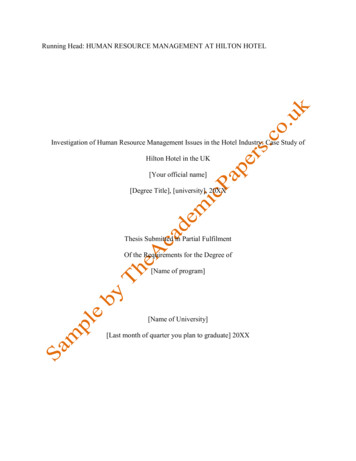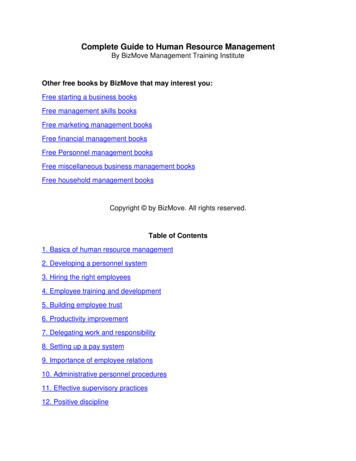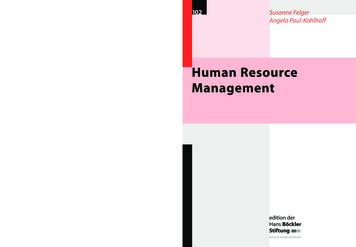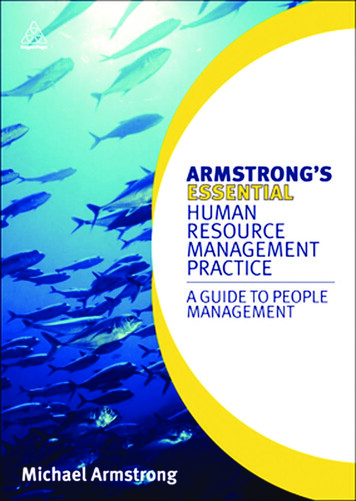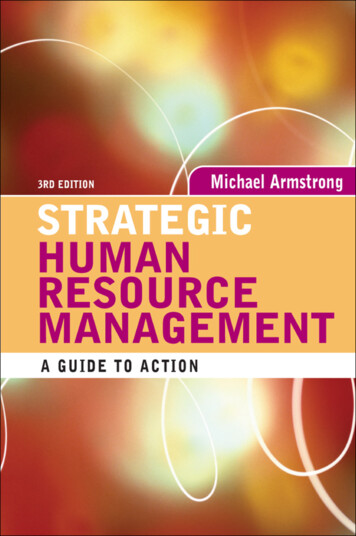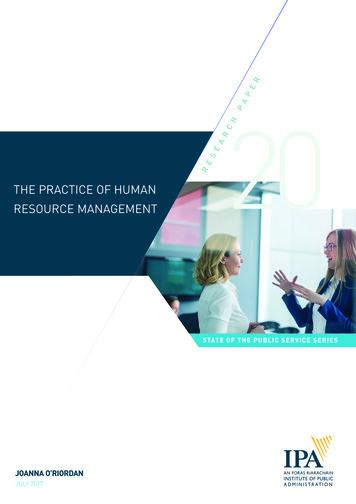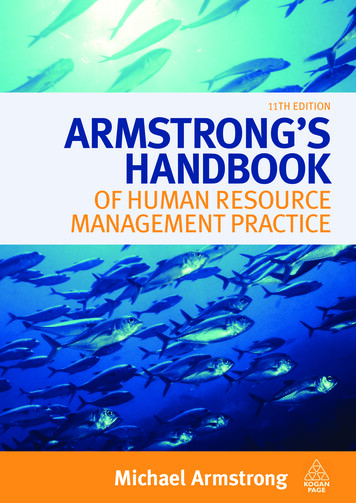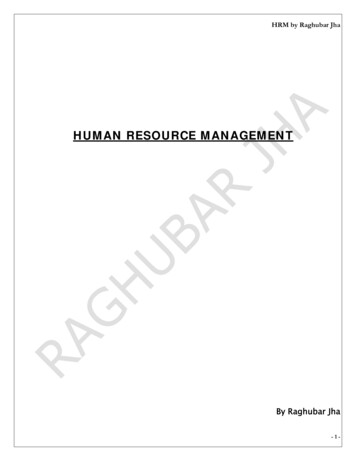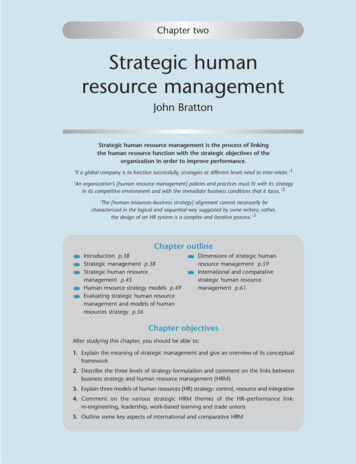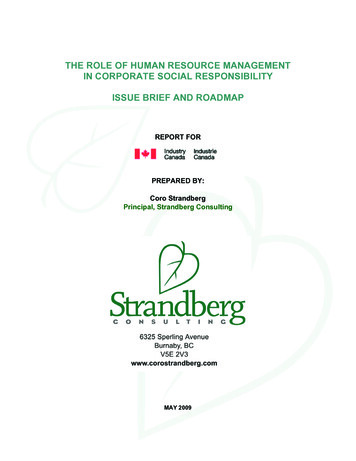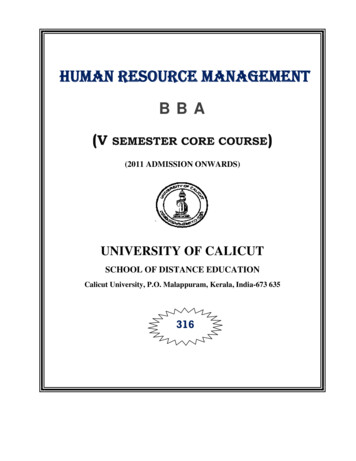
Transcription
HUMAN RESOURCE MANAGEMENTBBA(VSEMESTER CORE COURSE)(2011 ADMISSION ONWARDS)UNIVERSITY OF CALICUTSCHOOL OF DISTANCE EDUCATIONCalicut University, P.O. Malappuram, Kerala, India-673 635316
School of Distance EducationUNIVERSITY OF CALICUTSCHOOL OF DISTANCE EDUCATIONB.B.A(2011 ADMISSION ONWARDS )VSEMESTERCORE COURSEHUMAN RESOURCE MANAGEMENTPrepared by:Sri. Vineethan.TAssistant Professor,Dept. Of Commerce,Govt. College, Madappally.Scrutinized byDr. Venugoplan. KAssociate Professor,Dept. Of Commerce,Govt. College, Madappally.Layout & Settings: Computer Section, SDE ReservedHuman Resource Management2
School of Distance EducationCONTENTSPAGESMODULE - I5 - 17MODULE - II18 - 42MODULE - III43 - 46MODULE - IV47 - 57MODULE - V58 - 78Human Resource Management3
School of Distance EducationHuman Resource Management4
School of Distance EducationMODULE - 1INTRODUCTION TO HUMAN RESOURCE MANAGEMENTHuman Resource Management is a relatively new approach to managing human beings in anyorganisation. Human beings are considered as the key resource in this approach. Since anorganisation is a body of people, their acquisition, development of skills, motivation for higher levelsof attainments, as well as ensuring maintenance of their level of commitment are all significantactivities. All these activities fall in the domain of Human Resource Management.Human Resource Management is a process, which consists of four main activities, namely,acquisition, development, motivation, and maintenance of human resources.Scott, Clothier and Spriegel have defined Human Resource Management as that branch ofmanagement which is responsible on a staff basis for concentrating on those aspects of operationswhich are primarily concerned with the relationship of management to employees and employees toemployees and with the development of the individual and the group.Human Resource Management is responsible for maintaining good human relations in theorganisation. It is also concerned with development of individuals and achieving integration of goalsof the organisation and those of the individuals.Northcott considers human resource management as an extension of general management, thatof prompting and stimulating every employee to make his fullest contribution to the purpose of abusiness. Human resource management is not something that could be separated from the basicmanagerial function. It is a major component of the broader managerial function.According to Edwin B. Flippo, ―Human resource management is the planning, organising,directing and controlling of the procurement, development, resources to the end that individual andsocietal objectives are accomplished. This definition reveals that human resource (HR) managementis that aspect of management, which deals with the planning, organising, directing and controlling thepersonnel functions of the enterprise.FEATURES OF HRMThe features of human resource management can be highlighted as follows:1. It is an inherent part of management: Human resource management is inherent in the processof management. This function is performed by all the managers throughout the organisation ratherthat by the personnel department only. If a manager is to get the best of his people, he mustundertake the basic responsibility of selecting people who will work under him.2. It is a pervasive function: Human Resource Management is a pervasive function ofmanagement. It is performed by all managers at various levels in the organisation. It is not aresponsibility that a manager can leave completely to someone else. However, he may secureadvice and help in managing people from experts who have special competence in personnelmanagement and industrial relations.Human Resource Management5
School of Distance Education3. It is basic to all functional areas: Human Resource Management permeates all the functionalarea of management such as production management, financial management, and marketingmanagement. That is every manager from top to bottom, working in any department has toperform the personnel functions.4. It is people centered: Human Resource Management is people centered and is relevant in alltypes of organisations. It is concerned with all categories of personnel from top to the bottom ofthe organisation. The broad classification of personnel in an industrial enterprise may be asfollows: (i) Blue-collar workers (i.e. those working on machines and engaged in loading,unloading etc.) and white-collar workers (i.e. clerical employees), (ii) Managerial and nonmanagerial personnel, (iii) Professionals (such as Chartered Accountant, Company Secretary,Lawyer, etc.) and non-professional personnel.5. It involves Personnel Activities or Functions: Human Resource Managementinvolvesseveral functions concerned with the management of people at work. It includes manpowerplanning, employment, placement, training, appraisal and compensation of employees. For theperformance of these activities efficiently, a separate department known as Personnel Departmentis created in most of the organisations.6. It is a continuous process: Human Resource Management is not a “one shot” function. It mustbe performed continuously if the organisational objectives are to be achieved smoothly.7. It is based on Human Relations: Human Resource Management is concerned with themotivation of human resources in the organisation. The human beings can‘t be dealt with likephysical factors of production. Every person has different needs, perceptions and expectations.The managers should give due attention to these factors. They require human relations skills todeal with the people at work. Human relations skills are also required in training performanceappraisal, transfer and promotion of subordinatesObjectives of HRMThe primary objective of HRM is to ensure the availability of competent and willingworkforce to an organization. The specific objectives include the following:1) Human capital: assisting the organization in obtaining the right number and types of employees tofulfil its strategic and operational goals.2) Developing organizational climate: helping to create a climate in which employees are encouragedto develop and utilize their skills to the fullest and to employ the skills and abilities of the workforceefficiently3) Helping to maintain performance standards and increase productivity through effective job design;providing adequate orientation, training and development; providing performance-related feedback;and ensuring effective two-way communication.4) Helping to establish and maintain a harmonious employer/employee relationship5) Helping to create and maintain a safe and healthy work environmentHuman Resource Management6
School of Distance Education6) Developing programs to meet the economic, psychological, and social needs of the employees andhelping the organization to retain the productive employees7) Ensuring that the organization is in compliance with provincial/territorial and federal lawsaffecting the workplace (such as human rights, employment equity, occupational health and safety,employment standards, and labour relations legislation) to help the organization to reach its goals.8) To provide organization with well-trained and well-motivated employees9) To increase the employees satisfaction and self-actualization10) To develop and maintain the quality of work life11) To communicate HR policies to all employees.12) To help maintain ethical polices and behaviour.The above stated HRM objectives can be summarized under four specific objectives:1) Societal Objectives: seek to ensure that the organization becomes socially responsible to the needsand challenges of the society while minimizing the negative impact of such demands upon theorganization. The failure of the organizations to use their resources for the society’s benefit in ethicalways may lead to restriction.2) Organizational Objectives: it recognizes the role of HRM in bringing about organizationaleffectiveness. It makes sure that HRM is not a standalone department, but rather a means to assist theorganization with its primary objectives. The HR department exists to serve the rest of theorganization.3) Functional Objectives: is to maintain the department’s contribution at a level appropriate to theorganization’s needs. Human resources are to be adjusted to suit the organization’s demands. Thedepartment’s value should not become too expensive at the cost of the organization it serves.4) Personnel Objectives: it is to assist employees in achieving their personal goals, at least as far asthese goals enhance the individual’s contribution to the organization. Personal objectives ofemployees must be met if they are to be maintained, retained and motivated. Otherwise employeeperformance and satisfaction may decline giving rise to employee turnover.Importance of HRMHuman Resource Management has a place of great importance. According to Peter F. Drucker,―The proper or improper use of the different factors of production depends on the wishes of thehuman resources. Hence, besides other resources human resources need more development. Humanresources can increase cooperation but it needs proper and efficient management to guide it.Importance of personnel management is in reality the importance of labour functions of personneldepartment which are indispensable to the management activity itself. Because of the followingreasons human resource management holds a place of importance.1.It helps management in the preparation adoption and continuing evolution of personnelprogrammes and policies.Human Resource Management7
School of Distance Education2.It supplies skilled workers through scientific selection process.3. It ensures maximum benefit out of the expenditure on training and development and appreciatesthe human assets.4. It prepares workers according to the changing needs of industry and environment.5. It motivates workers and upgrades them so as to enable them to accomplish the organisationgoals.6. Through innovation and experimentation in the fields of personnel, it helps in reducing casts andhelps in increasing productivity.7. It contributes a lot in restoring the industrial harmony and healthy employer-employee relations.8. It establishes mechanism for the administration of personnel services that are delegated to thepersonnel department.Thus, the role of human resource management is very important in an organisation and it shouldnot be undermined especially in large scale enterprises. It is the key to the whole organisation andrelated to all other activities of the management i.e., marketing, production, finance etc. HumanResource Management is concerned with the managing people as organizational resources ratherthan as factors of production. It involves a system to be followed in business firm to recruit, select,hire, train and develop human assets. It is concerned with the people dimension of an organization.The attainment of organizational objectives depends, to a great extent, on the way in which peopleare recruited, developed and utilized by the management. Therefore, proper co-ordination of humanefforts and effective utilisation of human and others material resources is necessary.Scope of HRMThe scope of HRM is indeed vast. All major activities in the working life of a worker (fromthe time of his or her entry into an organization until he or she leaves the organizations) come underthe purview of HRM.The major HRM activities include HR planning, job analysis, job design, employee hiring,employee and executive remuneration, employee motivation, employee maintenance, industrialrelations and prospects of HRM.The scope of Human Resources Management extends to:1. All the decisions, strategies, factors, principles, operations, practices, functions, activities andmethods related to the management of people as employees in any type of organization.2. All the dimensions related to people in their employment relationships, and all the dynamics thatflow from it.3. The scope of HRM is really vast. All major activities in the working life of a worker (from thetime of his or her entry into an organization until he or she leaves it) come under the purview ofHRM.Human Resource Management8
School of Distance EducationAmerican Society for Training and Development (ASTD) conducted fairly an exhaustive study in thisfield and identified nine broad areas of activities of HRM.These are given below:a) Human Resource Planning: The objective of HR Planning is to ensure that the organization hasthe right types of persons at the right time at the right place. It prepares human resources inventorywith a view to assess present and future needs, availability and possible shortages in human resource.Thereupon, HR Planning forecast demand and supplies and identify sources of selection. HRPlanning develops strategies both long-term and short-term, to meet the man-power requirement.b) Design of Organization and Job: This is the task of laying down organization structure,authority, relationship and responsibilities. This will also mean definition of work contents for eachposition in the organization. This is done by “job description”. Another important step is “Jobspecification”. Job specification identifies the attributes of persons who will be most suitable for eachjob which is defined by job description.c) Selection and Staffing: This is the process of recruitment and selection of staff. This involvesmatching people and their expectations with which the job specifications and career path availablewithin the organization.d) Training and Development: This involves an organized attempt to find out training needs of theindividuals to meet the knowledge and skill which is needed not only to perform current job but alsoto fulfil the future needs of the organization.e) Organizational Development: This is an important aspect whereby “Synergetic effect” isgenerated in an organization i.e. healthy interpersonal and inter-group rela
Human Resource Management is a relatively new approach to managing human beings in any organisation. Human beings are considered as the key resource in this approach. Since an organisation is a body of people, their acquisition, development of skills, motivation for higher levels of attainments, as well as ensuring maintenance of their level of commitment are all significant activities. All .

